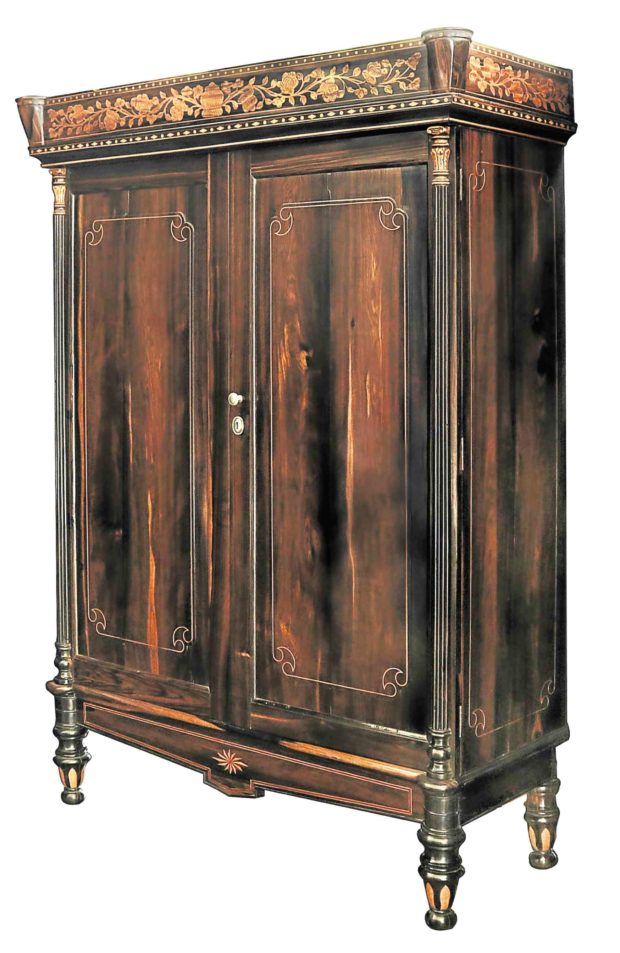
Exquisite hardwood furniture from the 19th century that formed part of the famous Romeo Jorge collection are among key lots of important antiques and objets d’art in León Gallery’s Spectacular Mid-Year Auction 2019 on June 22.
Highlight of the auction is the Romeo Jorge “Kamagong Aparador” from the second quarter of the 19th century. Made of kamagong and lanite, the piece of furniture stands on four vase-shaped feet carved with acanthus leaves carrying a drum-shaped entablature.
Between the top entablature is, according to antique expert Martin I. Tinio Jr., a frieze of lanite vines with flowers, leaves and buds of various sizes arranged symmetrically on either side of a central large flower. “The leaves and flowers are incised with black lines to give depth to the design and are definitely inspired by patterns found in embroidery and silverwork of that era,” said Tinio
The aparador has a starting price of P1.8 million.
Another lot from the Jorge collection is the “Baliuag Altar Comoda” from the last quarter of the 19th century.
Made of narra, kamagong and bone, it is “true to the Baliuag style,” according to social historian Augusto Marcelino Reyes Gonzalez III. “It is made from golden narra wood and is embellished with engaged posts of dark kamagong wood and various inlays of carabao bone, pale lanite and kamagong.”
Rare
“Altar Comoda” is very rare. The furniture is a “hybrid,” said Gonzalez, meant to be a storage for collections while also functioning as an altar for religious icons. This hybrid type of Baliuag furniture was only produced for affluent clients, inevitably from leading “hacendero” landowning and merchant families,” explained Gonzalez. “Few pieces are known and documented.”
Floor price is P1.4 million.
Romeo Jorge was an agribusiness industrialist who was a leading collector of art and antique in the 1980s together with Jaime Laya (for the Intramuros Administration), Paulino Que and Antonio Gutierrez.
“Today the magnificent collections (of the Intramuros Administration, Que, Gutierrez, and Jorge) remain as landmarks of excellence in the field of Philippine art and antiques, with each and every piece bearing rarity and importance in the national legacy,” said Gonzalez.
Episcopal chair
Another important lot is the Bishop’s Chair from the first half of the 19th century.
Made of baticuling wood, the chair comes from the ancient Augustinian missions of Central Luzon (Tarlac, Nueva Ecija, Pampanga, Bulacan) because it bears the symbol of the Augustinian order.
“This ecclesiastical armchair,” said Gonzalez, “has a caned oval back flanked by panels of carved foliate forms surmounted by a crest of piercework floral and foliar forms featuring the ubiquitous catmon flowers and framing the Augustinian emblem of a flaming heart pierced by two arrows over an open book.”
Floor price is P220,000.
Folk cabinet, ‘baul’
Another highlight is the Folk Ilocos Cabinet made of “golden narra” from the last quarter of the 19th century.
“It has two doors with sunburst motifs in relief framed by molded panels with two mock-drawers underneath decorated with incised floral and foliate decoration again framed by molded panels, the whole surmounted by a crest of intersecting palm leaves terminating in C-scrolls carved in relief,” said Gonzalez.
“It is an interesting, eccentric cabinet. Apparently, there was an enthusiastic folk woodworking tradition in the Ilocos during the last quarter of the 1800s. The artistic temperament of the folk furniture mirrored the Ilocano: robust, prudent, surefooted, but surprisingly expressive, jolly and fun-loving.”
Bidding will start at P100,000.
Then there is the 1850 Pair of Baul (chests) made of balayong or burled tindalo wood from Pampanga.
“The household chests of the 19th century had their antecedents in the massive hardwood chests that were used during the Galleon Trade between Acapulco and Manila from 1565-1815,” said Gonzalez. A surviving example is the massive hardwood chest marked “Obras Pias” from the 1700s owned by the Roman Catholic Church that is on display at the Museo de San Agustin in Intramuros.
Floor price of the pair of chests is P200,000.
Another important lot is the Filipino Wood Divan from the second half of the 19th century, which Gonzalez described as “clearly of American Empire derivation with tinges of English Regency.” —CONTRIBUTED
Visit www.leon-gallery.com.